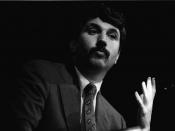�PAGE � �PAGE �1�
Ashley Watkins
October 12, 2008
PS 315 - Public Leadership (ON CAMPUS)
Book Review
The World is Flat - Thomas L. Friedman
Thomas Friedman came upon the material for his book The World is Flat by accident while traveling in India with the Discovery Times. While in India, Friedman visited Infosys Technologies Limited; it was from a conversation he had with the company's CEO, Nandan Nilekani, that Friedman developed his thesis for The World is Flat. Friedman argues that the global competitive playing field has been leveled. Thus, the world is flat. What he means by this is that a much larger group of people can collaborate and compete for global knowledge. Friedman's goal in writing this book was to understand how the world became flat as well as to recognize the consequences of the increasing rate of globalization and the flattening world.
In the first part of the book, Friedman explains how the world became flat.
He argues that there are ten forces that led to the flattening of the world: the collapse of the Berlin Wall; Netscape; work flow software; uploading; outsourcing; offshoring; insourcing; in-forming; and the steroids. Aware that these ten factors could not have caused the world to become flat on their own, Friedman goes on to explain what he describes as "the triple convergence". Friedman explains that "the triple convergence" is the way in which the ten forces "converged" to further flatten the global playing field. Friedman goes on to examine the way in which countries will adapt to "the triple convergence" in what he calls "the great sorting out".
Friedman uses the second part of the book to explore "America and the flat world". He uses David Ricardo's free-trade theory of comparative advantage to argue that free trade is...


